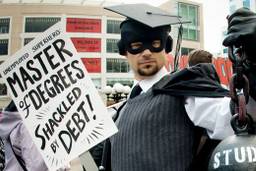There’s a case to be made that the single most intellectually and politically influential neighborhood in the United States is Chicago’s Hyde Park. Integrated, affluent and quiet, the 1.6 square-mile enclave on the city’s south side is like a tiny company town, where the company happens to be the august, gothic, eminently serious University of Chicago. Students at the U. of C. sell T-shirts that read “Where Fun Goes To Die,” and the same could be said of the neighborhood, which until very recently had a bookstore-to-bar ratio of 5:2.
But the university is probably best known for the school of economic thought it has produced. When the Chicago School first emerged in the ’50s, its zealous support of free markets and critique of government intervention were considered reactionary and extreme. Among elites in economics and politics the consensus was, as John Maynard Keynes had argued, that capitalism could only function with regular and robust government management. Indeed, so total was this consensus that in 1971 Richard Nixon announced a plan to impose wage and price caps in order to curb inflation, declaring, “We are all Keynesians now.” Just 25 years later, however, Bill Clinton, the first Democratic president to be re-elected since FDR, announced that the “era of big government is over.” He might as well have said, “We are all Chicagoans now.”
Neoclassical economics, as the Chicago School of thought is now called, has become an international elite consensus, one that provides the foundation for the entire global political economy. In the United States, young members of the middle and upper-middle class first learn its precepts in the academy. Polls routinely show that economists and the general public have widely divergent views on the economy, but among the well-educated that gap is far narrower. A 2001 study published in the U. of C.‘s Journal of Law and Economics showed that those with college degrees are more likely to subscribe to the views of neoclassical economists than the general public. This isn’t surprising. At elite colleges, economics is consistently one of the most popular majors (nearly a quarter of undergrads at the U. of C.), and across all schools, introductory economics, often a required course, has been one of the 10 most popular classes for the last 30 years. Graduate schools — from business to public policy to political science to, most notably, law — are now suffused with economic paradigms for understanding not only financial interactions but all human behavior.
Conservatives have long critiqued academia for the ways professors use their position to indoctrinate students with left-wing ideology, but the left has largely ignored the political impact of the way people learn economics, though its influence is likely far more profound. So in order to find out just what students learn when they learn economics, I headed down to Hyde Park, where the University generously let me enroll in “Principles of Macroeconomics” for a quarter.
— — — — — — — –
Allen Sanderson, 62, has been teaching the intro macro and micro courses at the university for the last 18 years and though he initially appears somewhat grave and understated, it is quickly apparent that he is a master of technique. His lectures skip along, propelled by a series of wry, contrarian quips, each punctuated with a visual rimshot: a slight pause and a thrust jaw. “When you hear, ‘The economics department at U. of C.,’ one’s free association is ‘pro-business, greedy bastards,’” says Sanderson (pause, jaw thrust) in the first lecture. “I tend to think that’s not the case. Greedy bastards we may be, but we’re not pro-business. Republicans tend to be very pro-business. It’s a genetic defect of Republicans. Democrats tend to be anti-business, another genetic defect. We are not anti-business; we are not pro-business. We are pro-choice in the ultimate sense of pro-market. Based on empirical work, macro and micro solutions are probably better worked out by private markets than government intervention.”
His second lecture begins with a thought experiment. Noting that there are only 26 spots left in the class for the 52 students who would still like to enroll, he asks, “How should we figure out who gets to go into the class?” The students — eager, studious and serious — shoot their hands up and offer a variety of ideas: Seniority? First-come, first-serve? Ask prospective students to write an essay? It takes about a minute for a confident young man to give the answer Sanderson’s looking for: “auction by price.”
“As a reasonable indication of how much you want something, how much you’re willing to pay is a pretty good means of measuring,” Sanderson says. “A lot of things in economics will turn in one way or another on price. Price has a lot going for it as a generalized expression of commitment. The thing we don’t like about, say, first-come, first-serve, is that if someone really wants to get in, they could start lining up now. But the problem is that I don’t really benefit from your expression of interest, whereas if you pay me, we both are benefiting.”
This makes sense, but I’m uneasy. Wouldn’t giving a place in class to the highest bidder result in the rich students getting in and the financial-aid kids being left out? And since people don’t have equal amounts of money to spend, how good a measure of desire is price in this situation?
“Random and first-come have the benefit of being fair,” Sanderson says, anticipating the objection. “There’s an interesting dichotomy of fair vs. efficient.” But, Sanderson asks, what, really, is fair? If we think some kind of random lottery drawing was a fair way of getting into the class, would that be a fair way of awarding grades? “Obviously not!,” I think. Why? Sanderson lets us mull that over, but the answer floats up immediately: because I work hard for my grades and I deserve them. In other words, those who work hard and get good grades are like those who work hard and have a lot of money to win spots that are auctioned by price.
“We’re trying to balance these things out,” Sanderson continues. “What’s efficient? What’s fair? Often they are in tension.”
— — — — — — — –
Efficiency is the Chicago School’s defining value. The free market economists who came before — most notably Austrian Friedrich Hayek — offered a philosophical critique of the political consequences of state regulation and control of the economy. But Milton Friedman, his colleague George Stigler and the entire Chicago School focused on the actual economic problems of state control, namely, inefficiency. They rejected Keynes’ contention that markets function best with routine government intervention and instead harkened back to Adam Smith’s classical conceptions of equilibrium. Chicago School theories gained popularity when global capitalism hit a major funk in the ’70s – a period of slow growth and high inflation. Friedman argued, plausibly, that it was too much government that had caused the problems.
What may seem a subtle rhetorical shift had major consequences. It transformed what had been conservatism’s moral argument about capitalism bestowing the most benefits on those who worked the hardest — and the inherent injustice of a coercive state forcibly redistributing capital — into a technical argument about the inefficiencies associated with non-free-market solutions and the perverse incentives that made any social programs destined to fail. Thus, arguments about the way the world should be were converted into assertions about how the world actually was. Or, to put in terms that economists favor, normative arguments became positive ones.
In the textbook Sanderson uses, author Michael Parkin defines the difference this way: positive statements are about “what is” and they “might be right or wrong.” Normative statements are about “what ought to be” and because they depend on values, they can’t be tested. “Be on the lookout,” Parkin warns, “for normative propositions dressed up as positive propositions.”
Parkin’s warning, however, turns out to be surprisingly difficult to heed. Neoclassical economics smuggles a great many normative wares underneath its positive trenchcoat, both in its assumptions about how humans operate — as individuals rationally maximizing their utility — and its implied preference for “markets in everything.” Because neoclassical economics always presents itself as a value-neutral description of the world, its ideological commitments can be adopted by those who learn it without any recognition that they are ideological. This is the source of some very spirited debate within the field itself. A growing global movement of “heterodox” economists has criticized the ideological confines and blindspots of the neoclassical approach. As Nobel Laureate Joseph Stiglitz put it, the dominance of the neoclassical model is a “triumph of ideology over science.”
In the popular press, however, such dissent is almost entirely absent. When protesters disrupted the 1999 World Trade Organization meeting in Seattle, WTO officials, mainstream economists and the New York Times’ Thomas Friedman ignored the fact that in much of the world neoclassical reforms had failed to produce the promised growth. Friedman went so far as to dismiss the protesters as “flat-earthers.” For Thomas Friedman (and, indeed, Allen Sanderson), people can’t “disagree” with neo-classical economics. They can only fail to understand it.
— — — — — — — –
As a standard part of his first lecture in both his macro and microeconomics class, Sanderson reads a David Barry quote: “Democrats seem to be basically nicer people, but they have demonstrated the management skills of celery. Republicans would know how to fix your tire, but they wouldn’t stop.”
In the wake of Katrina and Iraq, this might seem quaint, but what Sanderson is doing makes sense. Temperamentally, it reflects his own, libertarian-inflected, “pox-on-both-their-houses” centrism, but his insistence on political equanimity is also crucial to his pedagogical success. Students are most likely to have been exposed to macroeconomic issues within the context of political debates about free trade, the size of the budget deficit, tax rates, etc. In order to assure students that they aren’t just learning a set of political talking points, he must go out of his way to hammer home the fact that what he’s offering is unbiased and nonpartisan: positive not normative, facts not opinion. “I don’t have a dog in this fight,” Sanderson tells the students. So every joke about George Bush is followed by a joke about Hillary Clinton, every shot at a Democrat quickly balanced by a shot at Republicans.
The effect, intentional or not, is that Sanderson appears to represent the exact center of the political spectrum, and that can leave students with a strange perception of just where the center lies. During a discussion of flat, progressive and regressive tax structures, a student asked about the argument against the flat tax. “What’s wrong with the flat rate tax?” Sanderson replies. “Well, the bad thing was that Steve Forbes was the spokesman. It’s not obvious that there’s that much wrong with it. There’s sort of a movement out there for a flat rate tax. Because it strikes some people: What could be fairer than that? It also doesn’t distort incentives. It has a lot going for it.”
It’s true that there’s “sort of a movement” for a flat tax, but those in favor of what would be the single most regressive redistribution of wealth in American history are not located in the political center. Far-right Republicans like former House Majority Leader Dick Armey have long pushed the idea, as have conservative think tanks like American Enterprise Institute and the Heritage Foundation. But politically, it’s a non-starter. The basic notion of fairness that those who get more out of our economy should pay a greater percentage of their income in taxes is deeply embedded in American political culture, even during years of Republican domination. The students sitting around me, I start to fear, are going to walk out of the lecture thinking that the flat tax is a sensible, centrist idea. And as thousands of students pass through classes like Sanderson’s every year, I worry that it will become a sensible, centrist idea.
Sanderson’s politics aren’t one-dimensional, and he certainly isn’t a propagandist. But the fact remains that he has the predispositions of someone who “learned economics from Milton Friedman.” First, there’s a tendency to see trade-offs between equity and efficiency even where they might not exist. Dean Baker, an economist at the Center for Economic and Policy Research and author of the book The Conservative Nanny State, points out that policies can be both fairer and more efficient. For instance, Baker told me, “it is not clear that a flat tax is more efficient than a progressive income tax. This is entirely an empirical question. It is entirely possible that taxing middle-income workers and Bill Gates at a 25 percent rate will create more distortions than taxing middle-income workers at a 15 percent rate and Bill Gates at a 40 percent rate. … They want liberals to say that we care about fairness and they care about efficiency. This is crap. They find ways to justify redistributing income upward and proclaim it to be efficient. The reality is it is not fair and generally not efficient either.”
But when equity and efficiency trade-offs do arise, economists like Sanderson are systematically biased in favor of efficiency because that’s what they are experts on. Efficiency they can measure and analyze. Fairness? That’s the turf of philosophers and politicians. This tendency is most pronounced in discussions of economic growth, and how the benefits of that growth should be distributed. Sanderson paraphrases his Nobel Laureate colleague Bob Lucas, who says that “once you start to think about the benefits of high growth, it’s hard to think about anything else.” In other words, first worry about how best to grow the pie, then how to slice it up. Let efficiency trump equity, create wealth, and then you can use the extra wealth you’ve created to alleviate inequality.
This makes a certain amount of sense. But when this rhetoric comes to dominate our politics, the problem of inequality is never addressed. Now is always the time for growing, later is always the time to address concerns about equity. The result is predictable: In countries that have adopted the neoclassical policy prescriptions (including the United States), there has been an ever-widening gap between rich and poor.
— — — — — — — –
As taught by Sanderson, economics is a satisfyingly neat machine: complicated enough to warrant curiosity and discovery, but not so complicated as to bewilder. Like a bicycle, input matches output (wind the crank and the wheel moves), and once you’ve got the basics of the model down, everything seems to make sense. As the weeks go by, and I trek down to Hyde Park, fight for a parking space and slip in between the hundred-plus students into the lecture hall, I come to love the class. The more reading I do, the more sense the op-eds in the Wall Street Journal make. The NPR program “Marketplace” becomes interesting. I even know what exactly the Fed rate is. A part of the world that was blurry and obscure begins to come into focus. My classmates seem to feel the same way. “I never thought I’d be interested in economics,” one sophomore told me. “Sanderson convinced me I was.”
The simple models have an explanatory power that is thrilling. Once you’ve grasped the aggregate supply/aggregate demand model, you understand why stimulating demand may lead, in the short run, to growth, but will also produce inflation. But the content of that understanding turns out to be a bit thin. Inflation happens because, well, that’s where the lines intersect. “A little economics can be a dangerous thing,” a friend working on her Ph.D in public policy at the U. of C. told me. “An intro econ course is necessarily going to be superficial. You deal with highly stylized models that are robbed of context, that take place in a world unmediated by norms and institutions. Much of the most interesting work in economics right now calls into question the Econ 101 assumptions of rationality, individualism, maximizing behavior, etc. But, of course, if you don’t go any further than Econ 101, you won’t know that the textbook models are not the way the world really works, and that there are tons of empirical studies out there that demonstrate this.”
Take, for instance, the minimum wage. In Sanderson’s intro micro class, he uses a simple supply and demand model of a labor market to show why a minimum wage will cause unemployment, and therefore be self-defeating. “Most economists, myself included, are opposed to living wage ordinances and minimum wage laws period,” he says. But a series of empirical studies has established that the most recent increase of minimum wage in 1997 had essentially no impact on unemployment. In fact, in October, 650 economists, including five Nobel Laureates, signed a letter advocating an increase in the U.S. minimum wage to $8 an hour.
Of course, some elision and simplification is unavoidable. Sanderson’s not trying to create future economists, but rather give students “some sort of cultural literacy” about how the economy works. He often starts class by leading us through a kind of Socratic deconstruction of a newspaper article that commits some egregious economic sin. About midway through the semester, during the unit we spend learning about how the gross domestic product is computed, he reads to the class from an article in the Chicago Tribune with the headline, “Corporate Giants Dwarf Many Nations.” The piece compares the annual sales of large corporations like Wal-Mart with that of small countries, like Israel, showing that many of the world’s 200 largest corporations are as large as entire national economies, and therefore have a great deal of political and economic clout. After quoting at length, Sanderson points out how implausible it is that 200 companies, with one third of one percent of the world’s workforce, could produce 28 percent of the world’s economic activity. “There’s a word for it,” Sanderson says. “Two words, actually. The first is ‘Horse.’ “
The problem, Sanderson notes, is that “sales” is a terrible measurement for the economic output of a company like Wal-Mart, because it only produces a very small percentage of the value of any product is sells. When you buy pistachios at Wal-Mart, it’s not like those nuts were grown on a Wal-Mart farm. Wal-Mart bought them from someone and then resold them for a profit. “If we were counting GDP, we just want to count what’s the net contribution, what’s the value added?” he explains. “Last year, worldwide Wal-Mart sold $285 billion worth of goods and services, but paid manufacturers $220.” Sanderson’s point is pretty obvious, if you think about it. And yet the article gets it wrong over and over, which nearly sends Sanderson around the bend. “This happens to be the political rhetoric: ‘These 200 corporations dominate the world.’ They don’t. They’re a very small percentage of GDP,” Sanderson says. “Those who are criticizing very large multinational corporations are doing a disservice if they don’t get the math right.”
This contrarian approach is central to Sanderson’s worldview: It’s the counterintuitive, “everyone-says-x-but-really-what-matters-is-y” formulation that has become the staple of magazines like the New Republic and Slate. (A headline from Slate’s October 14 “Underground Economist” column: “Charity is Selfish.”) But as with any counterintuitive rhetoric, what matters is how you define the conventional “intuition” that you’re skewering. And with Sanderson, the target is almost always statist, regulatory and liberal: The idea that you can, indeed, get a free lunch, by, for instance, mandating better incomes for workers by raising the minimum wage. Thinking of economic policy as a series of trade-offs and opportunity costs and, most importantly, unintended consequences is a hallmark of the Chicago School, and it was a constant theme throughout the course: Whenever you try to alter the market, the market extracts its revenge.
In Sanderson’s zeal to play ‘gotcha’ with the press, he too can slant the pure data. That evening, I went online and found that Wal-Mart’s $65 billion of net revenue was still larger than the GDP of 132 countries, including Bangladesh, which has a population of 144 million people. I wrote an e-mail to Sanderson, who promptly wrote back, saying the bigger point was to drive home the problem with inappropriate comparisons and double counting. “I tried to point out that these apples v. oranges comparisons are all over the place,” he wrote, and added that the double-counting error could be found everywhere from the Wall Street Journal to some introductory textbooks. “Thanks,” he wrote, “for continuing the out-of-class dialogue.”
— — — — — — — –
Sanderson is so likeable and masterful that the entire quarter goes by with the class eating out of his hand: They take careful notes, class attendance is almost perfect every day and each pre-exam study session is packed. But the final unit of the class is devoted to free trade, and suddenly things change.
Sanderson begins the class by telling us that “in trade, there’s an enormous amount of agreement between economists about what constitutes the truth. The disagreements are between economists and everybody else.” His central contention is that allowing any two given countries to trade their goods freely will necessarily make both countries better off. It’s the same logic, he says, that we use everyday. When you decide to have someone do your dry cleaning or fix your car, you’re deciding to specialize in what you do best, and trade for the other things you need. Specialize and trade: That was Adam Smith’s central insight into the nature of the “wealth of nations,” and, Sanderson says, it remains as true today as it was then.
But when lecturing on trade, Sanderson’s tone is noticeably different. His agenda and ideology are more up front, such that the classes felt for the first time almost — almost — like propaganda. And during these lectures, something incredible happens. The class rebels. Whereas for the duration of the quarter Sanderson had made the students feel as if he was their guide in seeing through the Matrix, suddenly Sanderson morphs from being Laurence Fishburne to the FBI agent in a suit. The class prods and pushes back as if they are being fed spin. As Sanderson talks about the importance of nations specializing in whatever they have a comparative advantage in, a student raises his hand: “Isn’t there a problem if you put all your eggs into one basket, and then if there’s a problem with that sector you’re in trouble?”
That ends that day’s class, but it continues in the next. Sanderson argues that liberalized trade creates more jobs than it destroys. “Free trade creates winners and it also creates losers. It turns out that winners are quantitatively larger than the losers.” A student asks, flat out, “Why are we to believe that?” Sanderson restates his point, but the student holds his ground, saying he’s read that there simply doesn’t exist an accurate measure to figure out how many jobs are being created and destroyed. Sanderson concedes that this is true, but insists it “must” be a net positive.
You can hear papers rustling and side conversations breaking out. Hands begin to shoot up and Sanderson began to sweat noticeably as the mutiny spreads. One student asks about attaching labor or environmental protections to trade deals. Sanderson replies that such stipulations (like requiring workers be paid $14 an hour) simply operate like tariffs, raising the price of goods and “saving jobs in the U.S., union jobs that are relatively high paid, and taking people in developing countries who are not well off and making them poorer. I tend to be against laws that make poor people poorer.”
“OK,” responds the student, who with a beard and long hair looks a bit like the student radical who’s been missing all quarter. “Let’s say the standards are not ridiculous. The workers have a right to organize, or we can’t pollute the only source of the village’s water supply.”
“How do we define what’s ridiculous?,” Sanderson shoots back. “Once you start, it’s very difficult to draw the line, in terms of what workers have. Should other countries not trade with the U.S. because we have capital punishment? Should we not trade with countries that don’t allow abortion? My problem with sweatshops is, quite frankly, the only potential definition is people who work long hours for low wages, and that’s what the U.S. was 120 years ago. A lot of what economics is about is how to increase the world’s income, and not for Bill Gates and Oprah, but for the world’s poor. Unions don’t like trade agreements. They’ve never seen one they like, and they want to find a reason in environmental standards or things like that.”
“We do draw the line every day,” the student responds, not bothering to raise his hand this time. There are hands up all over and the class has now devolved into a free-for-all. “We don’t trade with Burma. We didn’t trade with Iraq. We do trade with Saudi Arabia. It’s not impossible to re-imagine how to draw the line.” Sanderson is not winning this argument. “These are tough issues,” he says, and the class ends.
It occurs to me that Sanderson’s problem is that he’s been too honest about his biases. It’s far more effective to communicate a worldview through subtext than to argue for it explicitly. For eight weeks, Sanderson had been the model of equanimity, the centrist arbiter of competing factions, and because of this students seemed to accept his word without question. But on the very first day of class he’d tipped his hand that he was an “ardent free-trader,” and his clear desire to have students come away believing, as he does, in the benefits of free trade, was backfiring.
By the next class, Sanderson has regrouped, and calmly and methodically leads the class through a Socratic dialogue. Tobacco farmers have lost their jobs because we smoke less: Does that mean we should have the government do something about it? People lose their jobs all the time because the work they do — whether opening envelopes for magazine subscriptions or wrapping Hershey’s Kisses — becomes automated. Trade works the same way as technological progress: While it might put some people out of work, in the end, it makes everyone better off. The class is nodding, attentive and silent.
Furthermore, free trade is a moral imperative because it makes poorer countries better off. “I don’t want to sound like Miss America,” Sanderson says as he wraps up the final class of the quarter. “I think world poverty is where it’s at in terms of where you try to place resources. My sense is that significant redistribution of wealth is probably not the answer. Part of it is that there is not enough wealth to redistribute. There’s not a lot of rich people and too many poor people. And the gap between rich and poor is too vast. It comes down to economic growth, how fast we can make economies grow. Economic growth does tend to raise all boats.”
As the class files out, I see a student I’d talked with a few times over the course of the quarter, an unassuming kid with a long mop of brown hair. I remember a conversation we’d had at the beginning of the semester: “I hope it doesn’t all end up to be wrong,” he’d said, referring to the Chicago School theories he was about to learn. “Like in Latin America. That worries me a bit.”
Six months after the class ended, I e-mailed him to ask whether he was still worried. “I got this e-mail right after my Econ 201 class, the intermediate sequence for the major requirement,” he wrote back. “So it looks like I’m no longer worried that what I’m learning is ‘wrong.’ Actually, the conversation we had doesn’t really make sense to me anymore. I now understand that any one school of economics can’t explain and predict all the intricacies of human economies.”
What he’d come to realize, he wrote, was that “it isn’t a question of correct theory or incorrect theory, but whether or not the results of the implementation of that theory are right or wrong in a moral sense.”
In other words, it’s a question that economics alone can’t answer.








